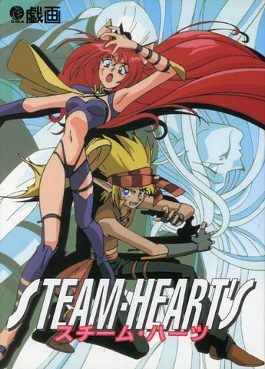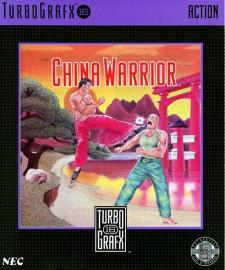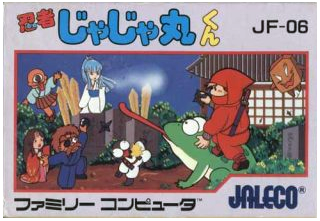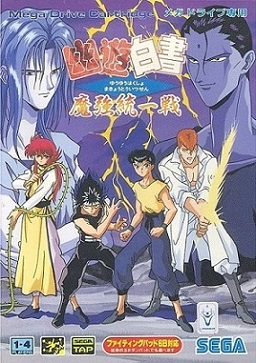
A handheld game console, or simply handheld console, is a small, portable self-contained video game console with a built-in screen, game controls and speakers. Handheld game consoles are smaller than home video game consoles and contain the console, screen, speakers, and controls in one unit, allowing players to carry them and play them at any time or place.

Radiant Silvergun is a shoot 'em up video game developed and published by Treasure. It was originally released in Japanese arcades in 1998 and subsequently ported to the Sega Saturn later that year. The story follows a team of fighter pilots in the far future who are battling waves of enemies summoned by a mysterious crystal dug up from the Earth. The player hosts an arsenal of six different types of shots to choose from, and a sword to destroy nearby targets. The stages are tightly designed to present players with scenarios that can be approached differently with the various weapon types.

Tetris Attack, also known as Panel de Pon in Japan, is a puzzle video game developed by Intelligent Systems and published by Nintendo for the Super Nintendo Entertainment System. A Game Boy version was released a year later. In the game, the player must arrange matching colored blocks in vertical or horizontal rows to clear them. The blocks steadily rise towards the top of the playfield, with new blocks being added at the bottom. Several gameplay modes are present, including a time attack and multiplayer mode.

The WonderSwan is a handheld game console released in Japan by Bandai. It was developed by Gunpei Yokoi's company Koto Laboratory and Bandai, and was the last piece of hardware Yokoi developed before his death in 1997. Released in 1999 in the sixth generation of video game consoles, the WonderSwan and its two later models, the WonderSwan Color and SwanCrystal were officially supported until being discontinued by Bandai in 2003. During its lifespan, no variation of the WonderSwan was released outside of Japan.

Treasure Co., Ltd. is a Japanese video game developer based in Tokyo known for its action, platform, and shoot 'em up games. The company was founded in 1992 by former Konami employees seeking to explore original game concepts and free themselves from Konami's reliance on sequels. Their first game, Gunstar Heroes (1993) on the Sega Genesis, was a critical success and established a creative and action-oriented design style that would continue to characterize their output. Treasure's philosophy in game development has always been to make games they enjoy, not necessarily those that have the greatest commercial viability.

Ikaruga is a shoot 'em up developed by Treasure. It is the spiritual sequel to Radiant Silvergun (1998) and was originally released in Japanese arcades in December 2001. The story follows a rebel pilot named Shinra as he battles an enemy nation using a specially designed fighter called the Ikaruga which can flip between two polarities, black and white. This polarity mechanism is the game's key feature and the foundation for its stage and enemy design. All enemies and bullets in the game are either black or white. Bullets which are the same color as the player are absorbed while the others will kill the player. The game features both single-player and cooperative modes.

Mr. Driller is a puzzle video game franchise created by Yasuhito Nagaoka and Hideo Yoshizawa for Namco. The eponymous first game was released in 1999 for arcades and several home consoles, such as the PlayStation. Gameplay in the series consists of controlling Susumu Hori, the titular Mr. Driller, or one of his friends and destroying colorful formations of blocks to make it to the bottom of a well. In order to survive, players need to collect air capsules to replenish their depleting oxygen and avoid being crushed by falling blocks.

Mega Man is an action-platform video game developed by Freestyle for the Sega Game Gear, and saw a North America-only release in October 1995. The game was sublicensed by British publisher U.S. Gold from Japanese-based company and creator of Mega Man Capcom. The game features Mega Man fighting against the mad scientist Dr. Wily and the six Robot Masters under his control, and features bosses and stages from Mega Man 4 and Mega Man 5.

Steam-Heart's is a vertically scrolling shooter and eroge developed by Giga and published by TGL. The story follows two siblings as they fight off a virus that is possessing the people in their world. The game features shooter gameplay paired with ample erotic cutscenes with scantily clad women. Steam-Heart's was initially released on PC-98 personal computers in 1994. It was released for the PC Engine Super CD-ROM² System in 1996 and then the Sega Saturn in 1998. All releases have been limited to the Japanese market. Critics generally found the gameplay to be average, with the erotic content being the sole distinguishing feature.

Entertainment Software Publishing, Inc. (ESP) was a Japanese video game publisher headquartered in Shibuya, Tokyo. It was founded in 1997 as a publisher for games developed by the Game Developers Network (GD-NET). GD-NET, which included companies such as Treasure and Game Arts, was established due to concerns over smaller developers not having the same financial backing like larger game companies did, as production of console games was beginning to rise. ESP was best known for publishing shoot 'em ups and role-playing games. While primarily a publisher, ESP also developed a handful of games internally.

Wonder Project J is a 1994 life simulation video game developed by Almanic Corporation and published by Enix for the Super Famicom. In the game, players take care of a boy Gijin (robot) created by Dr. Geppetto named Pino. Directed by Takashi Yoneda, the title was created by most of the same personnel that worked on previous projects at Almanic such as E.V.O.: Search for Eden. It was met with positive reception from critics and sold over 1.3 million copies in Japan, making it one of the best-selling Super Famicom games. A sequel, Wonder Project J2, was released in 1996 for the Nintendo 64.

China Warrior, known as The Kung Fu in Japan, is a beat 'em up video game created in 1987 by Hudson Soft for the PC Engine/TurboGrafx-16. The game received mixed reviews upon release, with praise for its large sprite graphics but criticism towards its gameplay.

Gunpey, often written as Gun Pey or GunPey, is a series of handheld puzzle games released by Bandai. It was originally released for the WonderSwan, and has been ported to WonderSwan Color, PlayStation, Nintendo DS and PlayStation Portable. The game was named as a tribute to the developer of the game, Gunpei Yokoi. He is known for developing several handheld consoles such as Nintendo's Game Boy, Virtual Boy, and Bandai's Wonderswan system. In the series, players move line fragments vertically in a grid in order to make a single branching line connect horizontally from one end to the other. The objective of the game depends on the selected game mode.

Ninja JaJaMaru-kun is an action-platform video game developed and published by Jaleco for the Famicom. It was released in Japan on November 15, 1985, and was ported to the MSX in 1986. The MSX version was released in Europe as Ninja II, being marketed as a sequel to Ninja-kun: Majou no Bouken, a game that used the name Ninja for its European MSX release.

Trip World is a 1992 platform game developed and published by Sunsoft for the Game Boy. It was released in Japan in 1992. The game's plot centers around the bunny-like being Yakopoo and his quest to retrieve the flower of peace so that peace will return to his disarranged world. The protagonist's trademark ability is to shapeshift into different forms.

Eschatos is a scrolling shooter, developed and published by Qute, which was released on April 7, 2011 for the Xbox 360. Despite the original Xbox 360 version only being released in Japan, it was a region-free release. A version for Microsoft Windows, published by Degica, was released in 2015. In 2021, Eschatos was ported to the Nintendo Switch exclusively in Japan, and was released worldwide on the Switch and PlayStation 4 the following year. Apart from the main game, two previous Wonderswan games by the developer, Judgement Silversword and Cardinal Sins, came bundled with the Xbox 360 release of Eschatos.

Cosmo Gang the Puzzle is a 1992 falling block puzzle arcade video game developed and published by Namco worldwide. The third game in its Cosmo Gang series, succeeding that year's Cosmo Gang the Video, players stack groups of blocks and aliens known as Jammers in a vertical-oriented well. The objective is to clear as many objects on the screen before they reach the top of the screen. Blocks are cleared by aligning them into complete horizontal rows, while Jammers are cleared by defeating them with blue-colored spheres.

Yo-kai Watch Blasters is a role-playing video game developed and published by Level-5 for the Nintendo 3DS. Blasters was originally released in two versions, named Red Cat Corps and White Dog Squad. The game is a spin-off based on the Blasters mini-game in the main series game Yo-kai Watch 2, and was released in Japan in July 2015 and worldwide by Nintendo in September 2018. Human characters are noticeably absent from gameplay, and players control yōkai in a beat 'em up action style instead.

Yu Yu Hakusho Makyō Tōitsusen is a 1994 fighting game developed by Treasure and published by Sega for the Mega Drive. It is based on the manga series Yu Yu Hakusho by Yoshihiro Togashi. The plot follows the protagonist Yusuke Urameshi, who is tasked by the ruler of the afterlife with solving detective-style cases involving both humans and demons threatening the living world. The story begins to focus heavily on martial arts battles as it progresses.

Mr. Driller is a 1999 puzzle arcade game developed and published by Namco. Versions for the PlayStation, Dreamcast, Microsoft Windows, Game Boy Color, WonderSwan Color, mobile phones, and iOS were also released. Controlling Susumu Hori, the titular "Mr. Driller", the player must dig their way to the bottom of the screen by destroying colored blocks that litter the playfield. Blocks will be cleared if four or more are touching each other, which can be used to cause chain reactions. Susumu has a constantly-depleting oxygen meter that can be refilled by collecting air capsules found throughout stages.




















